GothamTalks: Campaign Finance Reform Now

Gotham Gazette and New Leaders Council -- a nonpartisan, nonprofit leadership institute -- have partnered with Manhattan Neighborhood Network to create a series of video commentaries by New York City civic activists. GothamTalks is short video essays submitted through the New Leaders Council alumni network, which consists of hundreds of New Yorkers working in advocacy, government, campaigns, nonprofits, business, law, and other aspects of city life.
Like both the reporting we do at Gotham Gazette and the written op-ed columns we publish, the GothamTalks video commentaries range in subject, but are all meant to move the public discussion forward. Please watch, listen, and let us know what you think. Use #GothamTalks on social media, and tag us @GothamGazette and @NLC_NYC.
Note: The views expressed in GothamTalks are entirely those of the commentators, and not of Gotham Gazette or New Leaders Council.
************
March 12, 2018
Michael Pernick
Campaign Finance Reform
Sunlight for Subsidies
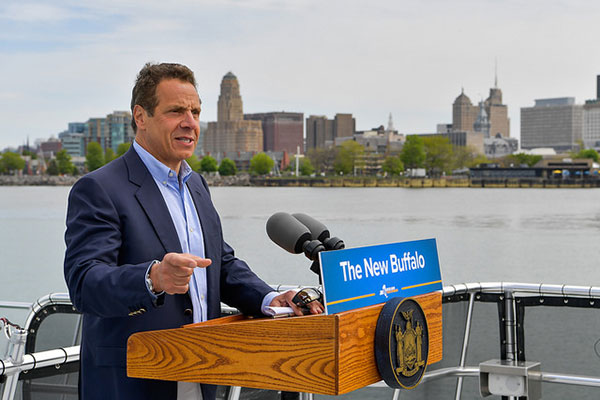
Gov. Cuomo in Buffalo (photo via The Governor's Office)
New York State and local governments spend over $8 billion annually in taxpayer money, giving subsidies to businesses through tax abatements and credits, low or no interest loans, grants, and capital investments like building factories. Eight billion dollars could otherwise pay for the MTA Subway Action Plan in addition to the entire 5-year capital plan for New York City Housing Authority (NYCHA). Instead it is awarded to wealthy companies like Alcoa, IBM, Goldman Sachs, Tesla, Verizon and JP Morgan Chase.
While spending billions, Governor Cuomo and Empire State Development have not acted on common-sense transparency measures that provide basic information taxpayers deserve to know: the types of benefits companies are receiving; the cost to taxpayers; and the number and cost of jobs created or retained.
Their inaction comes as the governor’s former senior advisor Joe Percoco was convicted on three federal corruption counts, including solicitation of bribes, in the first of two trials involving the alleged rigging of contracts tied to upstate mega-development projects worth hundreds of millions of dollars in business subsidies.
New Yorkers deserve to know more about economic development money being spent, including where it is going and what the money is actually producing.
Democratic Assemblymember Robin Schimminger and Republic Senator Tom Croci have introduced legislation (A.8175/S.6613-B), which would create a “Database of Deals” listing all projects awarded to a particular company, detailing subsidies received, and what New Yorkers are receiving for their return on investment in the taxpayer cost per job. The bill passed out of committees in both houses last year but never made it to the floor for a vote.
The Assembly and Senate each included a similar proposal in one-house budget resolutions passed on Wednesday. Meanwhile, the New York City Council passed legislation in December codifying its own “Database of Deals” established by the city’s Economic Development Corporation (EDC.) EDC had already made economic development in New York City more transparent by publishing a map showing major projects and their essential data across the five boroughs.
A state “Database of Deals” is fundamental transparency modeled on existing disclosure in numerous states of different political stripes including Florida, Maryland and Indiana. This reflects the near-unanimity on the need for greater transparency and accountability of business subsidies.
While states fervently compete to give taxpayer subsidies to the world’s wealthiest corporation, Amazon, for its second headquarters, the way in which public money is awarded is being challenged from the left and the right. Nationally, the progressive labor-backed Good Jobs First has long advocated for economic development accountability while the conservative Koch Foundation is seeking proposals to “identify and develop measures to provide transparency and accountability to corporate welfare.” In New York, groups as ideologically varied as the Working Families Party, Citizens Budget Commission, and Empire Center have questioned the state’s economic development practices.
But Governor Cuomo need look no further than his own 2013 Tax Reform and Fairness Commission to understand the need for transparency and accountability of business subsidies. In a report written for the commission entitled New York State Business Tax Credits: Analysis and Evaluation, the authors concluded, “There is, however, no conclusive evidence from research studies conducted since the mid-1950s to show that business tax incentives have an impact on net economic gains to the states above and beyond the level that would have been attained absent the incentives. In addition, business tax incentives violate principles of good tax policy and tenets of good budgeting.”
Despite the questioning of their efficacy, Governor Cuomo’s Executive Budget proposes over $2 billion in new spending and tax credits on business subsidies. Last year, the Assembly and Senate wrote the governor a blank check, increasing economic development spending without passing any legislation that would make the spending more transparent or measure the effectiveness of whether, and which, business subsidies work best.
This year, Reinvent Albany and fiscal and transparency watchdog groups are urging the governor and Legislature to act on four measures to make taxpayer spending on business subsidies more transparent and accountable, including the “Database of Deals.”
They should act swiftly to restore the public trust, which has been battered by federal indictments and sordid accounts of insider dealing at trial.
***
Alex Camarda is senior policy advisor for Reinvent Albany. On Twitter @alex_camarda and @ReinventAlbany.
***
Have an op-ed idea or submission for Gotham Gazette? Email This email address is being protected from spambots. You need JavaScript enabled to view it.
Don’t Let Congestion Pricing Push Accessible Taxis Off the Road
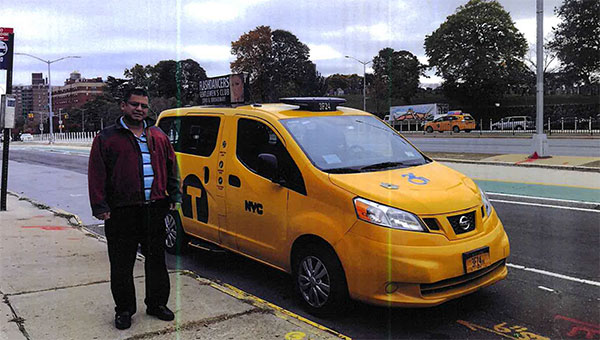
Masud Chowdhury, the author
As a longtime yellow taxi driver, I was proud to be among the first to drive one of the city’s wheelchair-accessible taxis, which are equipped to serve New Yorkers with disabilities. There are now around 2,000 accessible yellow taxis in New York City as the industry continues striving to become 50 percent accessible by 2020.
But it might be impossible for taxi drivers like me to keep our accessible vehicles on the road if we are hit with high fees under a congestion pricing system designed to raise funds for mass transit repairs. While the concept of congestion pricing is a good thing and more money must be generated for our subway system, the fact is that it would be unfair to target yellow taxis under such a program.
The problem here is that state officials are in the process of considering potential congestion pricing plans that would treat taxis in the same way as app-based ride-hailing companies like Uber and Lyft. Although that might sound fair, in reality it is not fair at all.
Yellow taxis have already contributed hundreds of millions of dollars to our subways and mass transit infrastructure, as well as providing an important source of accessible transportation. Uber and Lyft, both multi-billion-dollar companies, have done neither of these things – and any congestion pricing plan must hold these companies accountable without harming hardworking taxi drivers who are already doing the right thing.
New Yorkers must remember that, since 2009, yellow taxis have been paying a 50-cent fee to the MTA on every single ride, generating significant revenue for mass transit. Uber and Lyft have refused to follow suit and instead pay sales tax, which does not provide nearly as much support to the subway system. In fact, MTA officials have acknowledged in the past that the rapid growth of app-based companies has deprived the state of funding that could have gone to support mass transit infrastructure.
At the same time, while cabbies like me have put a great deal of effort into driving accessible taxis that are much costlier and more difficult to maintain, Uber and Lyft have done nothing to put their own accessible cars on the road. We are already bearing a heavy burden to provide this important service to thousands of wheelchair users – and these billionaire companies are not.
And let’s be real – we all know these companies have been the much bigger driver of added congestion in New York City. Since 2013, the number of vehicles for Uber, Lyft and other similar companies has nearly doubled from 47,000 to more than 100,000 in 2017, while the yellow taxi industry remains capped at roughly 13,500 medallions.
When you look at all the facts, there is simply no reason for state officials to even consider a congestion pricing plan that would treat taxi drivers like me the same as companies like Uber and Lyft. It wouldn’t just be unfair – it could make it even harder to keep costly accessible taxis on the road, and that would be a problem not just for me but for so many New Yorkers with disabilities.
On behalf of other drivers feeling the same concerns, I sincerely hope that Governor Cuomo and the state Legislature will keep these important issues in mind and develop a congestion pricing framework that is fair to everyone on the road – including yellow taxis.
***
Masud Chowdhury drives a wheelchair accessible taxi. A yellow taxi driver for more than 20 years, he lives with his family in Ozone Park, Queens.
***
Have an op-ed idea or submission for Gotham Gazette? Email This email address is being protected from spambots. You need JavaScript enabled to view it.
Offshore Wind, Onshore Justice
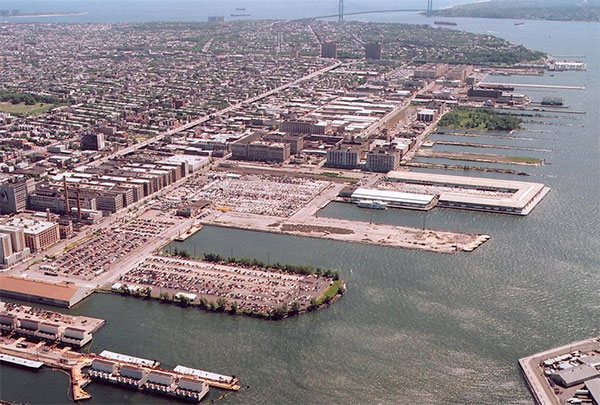
the Sunset Park waterfront
In New York City, we have learned from hard experience that our energy, environmental, and economic systems are highly interrelated. Decades of underinvestment in low-income communities of color – particularly from the loss of blue-collar industries -- compounds the profound vulnerability of these neighborhoods to climate change.
Beyond New York, 2017 saw ten consecutive Atlantic hurricanes, a historical first: Irma was the strongest storm to reach beyond the Caribbean; Harvey brought the greatest rainfall; and months after Maria wrought unprecedented devastation, half of Puerto Rico is still in the dark. For both the Global South and South Brooklyn, the time for incremental solutions has passed. We need an immediate and just transition towards a regenerative economy.
At UPROSE, a community-based organization in Sunset Park that advocates for sustainable economic development and environmental justice, our advocacy for climate justice is rooted in our struggles against displacement—displacement by rising waters and rising costs of living. The Climate Justice Alliance is a national collaborative of over 50 community-based and support organizations working to forge a scalable, and socio-economically just transition away from an extractive economy and towards local living economies.
Together, we are calling for the creation of new offshore wind manufacturing and logistics jobs on New York City’s waterfront to strengthen neighborhood resilience and make the case against re-zonings that irreversibly impair our capacity to address climate change locally.
Sunset Park is home to one of the city’s last working waterfronts and is today the target of rampant commercial speculation. Offshore wind energy can address the neighborhood’s vulnerabilities by saving maritime industrial sites, displacing dirty fossil-fuel plants that disproportionately affect people of color, and creating thousands of local jobs. The Department of Energy expects 40,000 such jobs by 2030 – and those opportunities will accrue wherever the ports and workforce are.
Positioning New York City at the center of this industry would localize supply chains and capture jobs for a fast-growing regional market. By 2020, our waterfront could see the first wave of opportunities: welding and turbine final assembly jobs, all under the banner of organized labor. Significant benefits to ancillary businesses could prioritize M/WBEs and lift local economies.
To advance this vision, Mayor de Blasio can take three actions.
First, the City can leverage its purchasing power to catalyze offshore wind construction. Second, the City can prioritize offshore wind uses at its waterfront industrial sites. Third, it can partner with local groups like UPROSE, labor, industry, and CUNY to ensure community members have the necessary skills to work in the industry. These actions will bring to the city reliable, locally-sourced clean energy and new career pathways for working waterfront neighborhoods.
The history of New York City was written at the water’s edge. How we leverage our waterfront at this inflection point will define our era’s response to the dual crises of growing climate disruption and mounting inequality. The City is today presented with a clear and decisive opportunity to act boldly and demonstrate its commitment to economic, environmental, racial, and climate justice. Anything short of this would be throwing dust to the wind.
***
Elizabeth Yeampierre is Executive Director of UPROSE, an environmental justice community-based organization in Sunset Park. She was the first Latina Chair of the US EPA National Environmental Justice Advisory Council and currently serves on Mayor de Blasio’s Sustainability Advisory Board.
Angela Adrar currently serves as the Executive Director of the Climate Justice Alliance, a 55+ member coalition of urban and rural frontline communities and organizations in the climate change movement. She has served as a leading member of local and international groups dedicated to food and environmental justice.
***
Have an op-ed idea or submission for Gotham Gazette? Email This email address is being protected from spambots. You need JavaScript enabled to view it.
Want to Fix High Rent? Look to Hotels, Not Hardworking Home-Sharers
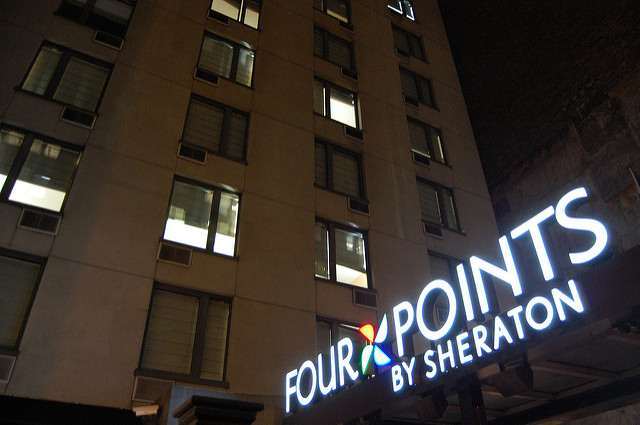
(photo: Andrew Russeth via Flickr)
If you’ve lived in New York City anytime in the last half-century, one thing is as certain as the sun will rise: the rent is just too damn high.
Now, in recent weeks, defenders of the hotel industry would have you believe that this is some new phenomena to be entirely blamed on hardworking home-sharers. How dare they!
I don’t buy it, and neither should you. This is all just part of the hotel industry lobby’s smear campaign, funded by big corporate hotels, like Trump Hotels in New York City. Let’s walk through their mudslinging playbook one step at a time and then talk about the truth.
Step one: Cite a “report” authored by a Canadian researcher and based on unreliable data and offensive racial profiling of hosts -- and most importantly, paid for by the hotel industry lobby -- and pass it off as serious academic research. Falsely claim that New Yorkers sharing their homes are responsible for gentrification.
Step two: Demonize New Yorkers sharing their home so that they can afford to start a business, pay their bills -- and even combat those rising rent prices and stay in their home. Accuse these law-abiding people of gaming the system and operating in secret, and falsely claim that they are the single reason rents are increasing. And go for the shock and awe effect: compare them to President Trump (who, by the way, is a famous hotelier, for anyone looking to make accurate connections).
Step three: Erroneously claim that Airbnb doesn’t share data about listings, hosts, and impact on the local economy. Paint Airbnb and home-sharers as a faceless, opaque, corporate special interest.
Check, check, and check for the hotel lobby.
Over the years, I’ve become skeptical of any front group that will stop at no end to deliberately demonize people and cast blame. It’s a page right out of the Trump playbook - under the chapter titled, “Fake News.”
Because in the case of home-sharing, the truth - the real truth - tells a different story.
The truth is that increasing costs of rent, property taxes, and utilities are resulting in some New Yorkers, particularly in communities of color whose families have lived in their neighborhoods for generations, being pushed out of their homes.
The truth is that, for these New Yorkers under increasing pressure to make ends meet, home-sharing platforms like Airbnb have been a tool of economic empowerment, especially in communities of color. It helps New Yorkers pay for that unexpected doctor’s bill, afford their taxes, fund a new business - and in the case of Airbnb, it’s even helped 79 percent of hosts to stay in their homes. The cost of living is not going down, but in the case of these New Yorkers, home-sharing has ensured that it doesn’t overtake them and their families.
The truth is that home-sharing has helped New Yorkers take control of their economic future. With tourism booming, these new tools have helped expand economic opportunity to New Yorkers, not just hotel owners and others who have traditionally held the wealth and the power in our city.
But here’s the most important truth: if any one party is to shoulder the blame for the declining affordability of our city, it’s the hotel industry that has that dubious honor.
A recent report by the Internet Association found that hotel development (not home sharing) cost the city affordable housing. This report looked at public data, showing that between 2010 and 2016 hotel development “resulted in the loss of more than 750,000 square feet of pre existing residential space and 773 pre existing residential units.”
The hotel industry is all too willing to cast home sharing New Yorkers as the culprits of the affordable housing crisis. But it’s clear that is just a diversion - because when it comes to their big, brand-spanking-new hotel developments, they aren’t putting their money where their mouth is. Consider this truth bomb dropped in that same report:
“If just half of the total new hotel space had been used for residential purposes and 20% of that space was dedicated to affordable housing, more than 2.9 million square feet of market-rate housing and over 727,000 square feet of affordable housing could have been created. That is the equivalent of 3,878 market-rate and 969 affordable one-bedroom units, assuming an average unit size of 750 square feet.”
Next time the hotel industry blames New Yorkers for the affordable housing crisis, ask its representatives how many residential buildings will be converted into housing for visitors. Ask them what new hotel developments will include affordable housing. Ask them why they aren’t partnering with advocacy groups or the city to build new affordable housing. And most importantly, ask why the hotel industry is prosecuting ordinary New Yorkers just trying to make ends meet.
***
Rev. Dr. Johnnie M. Green Jr. ios Senior Pastor, Mount Neboh Baptist Church and President of MPAC.
***
Have an op-ed idea or submission for Gotham Gazette? Email This email address is being protected from spambots. You need JavaScript enabled to view it.
Making the City’s Vacant Land Work for the Public
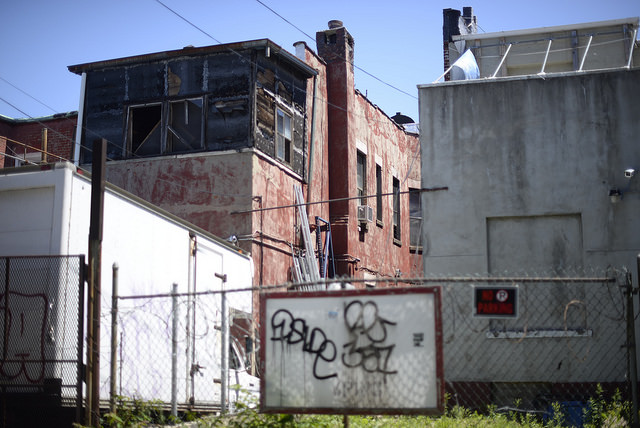
(photo: Sofie Hecht/Gotham Gazette)
Last month, the city’s Department of Housing Preservation and Development (HPD) announced that it selected developers to build affordable housing on 87 city-owned vacant lots, which could produce almost 500 affordable homes. This came the day after Comptroller Scott Stringer released a report criticizing the city for moving slowly on developing such lots.
As New York City staggers through the unrelenting affordable housing, homelessness, and displacement crises this plan is a missed opportunity that we can not tolerate. The city has repeatedly squandered the most value asset - land - it has in fighting these crises. Instead of giving away these vacant lots, the city should keep them and create a public land trust.
New York City owns 1,125 vacant lots. For decades it has relied on an insider-favoring process that turns over vacant properties to private developers and some non-profit developers. That number doesn't include city-owned distressed properties, which is bound to spike as foreclosures are nearing great recession levels. In either case, the transfer comes with laughable requirements for (and definitions of) affordable housing.
This process is the result of a long retreat from the public ambition that defined New York City during its period of great growth in the first half of the 20th century. An activist city government - albeit one tainted by machine politics and systemic racism - built institutions that expanded the very idea of what public life could be and made modern New York City possible. That all ended in the 1970s and left subsequent leaders wary of ambitious public growth and reliant on powerfully connected private actors.
This must change. Our over-reliance on the private market has demonstrably failed the public interest and carries much of the blame for the mess we are in.
Using the community land trust model, the city should retain ownership of the land - removing it from the speculative market that drives up prices - and contract out development based on a fixed equity model that incentivizes construction while limiting costs. It would then directly own and manage this housing stock, guaranteeing that 100% of it is permanently affordable for low- and middle-income households.
Make no mistake, what I am suggesting is public housing. A new, 21st century form that avoids the previous century’s mistakes of massive public housing developments while retaining its public virtues.
Public housing, for all of its problems (thanks to a loss of $1 billion in federal funding since 2000, with more reductions on the way), is still the best vehicle for providing New Yorkers with sustainable affordable housing.
Despite its operational failures, NYCHA currently offers an average monthly rent of $509 to over 400,000 New Yorkers in 176,000 homes and has a waiting list of 257,000 families. Public housing works and we need more of it.
A public land trust that takes advantage of small-site development on vacant lots would work even better as a public housing model in today's economic, political, and social landscape. Instead of the discredited 'shotgun' approach of megablock development that destroyed existing communities while isolating its newly created ones, this approach would be a syringe-sized injection of affordability into existing communities and landscapes.
Neighbors would barely notice the physical changes while enjoying the practical protections of permanent affordability taking root across individual sites. Most of these lots are in distressed neighborhoods that are at high risk of displacement as speculative developers (many of them private equity firms) swoop in. The best, fastest way to address displacement in these neighborhoods is through public-owned land anchoring their development.
The community land trust model works, too. It has successfully provided permanent affordability across the United States for decades, notably in Burlington, Vermont (initially supported by then-mayor Bernie Sanders) and in Dudley Square in Boston (created by local residents who were granted eminent domain). Even here in New York City, the city's first trust, Cooper Square, has quietly managed hundreds of homes in the Lower East Side as a community land trust since 1994.
Speaking of Cooper Square, through its efforts along with the New Economy Project and NYCCLI, the community land trust model has finally started to get the attention it deserves in New York. Last year HPD and Community Enterprises announced $1.65 million in initial funding for the creation of new CLTs and training programs. Many elected officials like then-Borough President Scott Stringer, Council Members Donovan Richards and Margaret Chin, and Attorney General Eric Schneiderman have all worked to expand CLTs in the city.
These developments represent the chance for a fundamental shift in how to create permanent affordable housing in New York City. The land trust model does not rely on excessive tax-subsidies to private developers, flimsy definitions of affordability, or unenforceable protections for maintaining affordability over time. It is simple and sustainable. We should all be excited that the city finally sees this as a viable policy tool.
However, if Mayor de Blasio wants to deliver on his promise to build or protect 300,000 affordable housing units while also recommitting to public housing and NYCHA, he should take the next step by transferring the city’s many vacant lots into a public land trust.
We know the model works. The city knows the model works. Usually the hardest part is acquiring the land, but the city already has it. There is nothing to stop a public land trust from getting into the fight.
New York City was once capable of envisioning and delivering bold progress for the public good. We need this again, updated for the 21st century. The mayor has at the very least claimed this rhetoric and along the way tapped into a respondent audience in many corners of the city. Now it is time to act.
***
Peter Harrison is CEO/Co-founder of homeBody, a public benefit startup. On Twitter @PeteHarrisonNYC.
***
Have an op-ed idea or submission for Gotham Gazette? Email This email address is being protected from spambots. You need JavaScript enabled to view it.
Can the De Blasio Administration Really Register 1.5 Million More Voters?
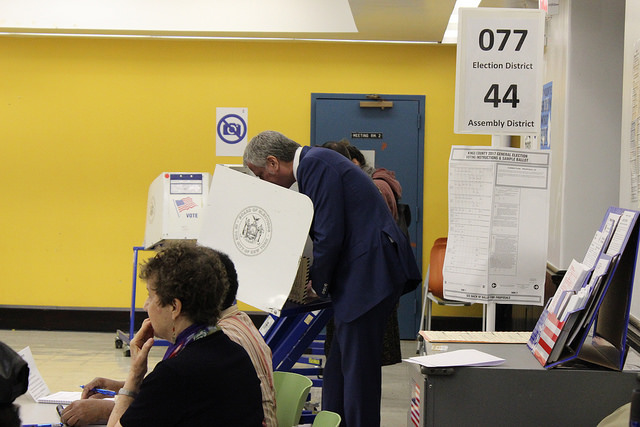
Mayor de Blasio voting (photo: Samar Khurshid/Gotham Gazette)
New York City Mayor Bill de Blasio recently announced a DemocracyNYC plan. One big goal: “to register 1.5 million New Yorkers to vote over the next four years.”
To make this work the mayor will create a new city leadership post: Chief Democracy Officer. How hard will it be for this new chief to meet the mayor’s goal?
Let’s do some rough math, based upon recent enrollment, census, and vital statistics data:
According to estimates in the most recent American Community Survey, there were 5,402,352 citizens of voting age in New York City in 2016 (plus or minus 22,325).
According to the state Board of Elections, in November of 2017 there were 5,053,842 registered voters in the city. That’s 93.5% of the eligible citizens.
Let’s make two initial assumptions to maximize the number of potential additional registrants among those of voting age now to make the CDO’s job more possible. First we’ll put aside reasons for disqualification other than age that would further reduce the number of those eligible but not registered (in prison or on parole for a felony, judged mentally incompetent by a court, voting elsewhere). Second, we’ll add that 22,325 to the estimate – that is, make the high side assumption of the number of age- eligible citizens while remaining within the statistical range of error.
That results in 370,835 citizens who are of voting age now and not registered.
Additionally, there are about 372,000 teenagers in New York City who will reach the age of 18 in the next four years. Of all people in the city over the age of 18, about four in five (80.5%) are citizens. The percentage of citizens among younger people, many born here of immigrant parents, is likely higher. They are not all citizens, but again let’s count more rather than fewer as likely to be eligible to register to vote: 9 in 10 of them. That would be 334,800.
That brings the available target total of potential new registrants to 705,635.
People from elsewhere in the country or living abroad (but not new immigrants) will move into and out of the city during the mayor’s second term. For now let’s just consider those moving in. Some will be children. Some won’t be citizens. A high side assumption from past experience of the number who can be registered: 200,000.
That brings us to 905,635 potential registrants.
Uh oh. We are 594,365 short.
Of course there are all those people who move within the city. They change their addresses. They need to re-register. Maybe the mayor meant to include them; he did not say the Chief Democracy Officer would have to find “new” registrants. So let’s give him the benefit of the doubt. Again we have to watch out for kids, non-citizens, and those already included in our count as not registered. Estimating from federal statistics on people moving annually within and between counties for 2011-2015, it looks like 483,000 is a reasonable number.
Still not there: 1,388,022 (OK, though, we’re getting within shouting distance). To meet the mayor’s goal the Chief Democracy Officer must find about 112,000 more people eligible to register in the next four years, and register them all. Where?
But wait a minute, that’s just the additions. How about the subtractions?
The Empire Center and others have noted that New York City’s population continues to grow every year because immigrants from abroad outnumber the many already living here who are leaving. Less noticed, most of those leaving are voters or vote-eligible, while those who are arriving are non-citizens. A conservative estimate is that 189,000 actual or potential registrants will move out of the city over the next four years.
Finally, there’s mortality. About 212,000 New Yorkers will die during Mayor de Blasio’s second term, more than 95% of whom are voting age. Of course, some - probably a smaller portion than for the city population as a whole - will be non-citizens. A reasonable, conservative estimate is that death will reduce New York City’s potential electorate by 171,000.
One-hundred-eighty-nine thousand plus 171,000 equals 360,000. Departure and mortality will reduce the city’s potential electorate in the next four years by about 6.5%.
Implications:
-Registering 1.5 million people to vote in New York City over the next four years is an impossible dream.
-Registering all of the age-eligible citizens now in the city won’t significantly expand the current electorate; it will keep it about the same size.
-The largest pool of potential registrants during Mayor de Blasio’s second term is comprised of people living in the city who are already registered, but changed their addresses.
-It would be truly extraordinary if the city’s voting roles grew by half-a-million registrants in the next four years.
The bottom line: If I were asked to be the new Chief Democracy Officer, the first thing I’d do is some serious counting. Then I’d call the mayor, to renegotiate the voter registration goal.
***
Gerald Benjamin is Director of The Benjamin Center at SUNY New Paltz.
***
Have an op-ed idea or submission for Gotham Gazette? Email This email address is being protected from spambots. You need JavaScript enabled to view it.
Expanding Immigrant Access to Health Care in New York
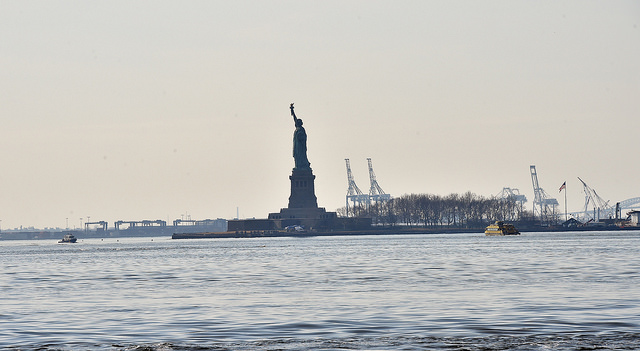
(photo: Kevin P. Coughlin/Governor's Office)
In January of 2017, after living in this country for 17 years, I was able to access health insurance for the first time in my life. I became eligible as a new graduate studentl at NYU, which had a Student Health Insurance Plan—and, because in New York, DACA (Deferred Action for Childhood Arrivals) recipients were eligible for health insurance.
Now, when I am ill or in need of a checkup, uncertainty and stress are no longer part of the equation. When I feel sick, I no longer need to try to force my body into thinking I’m not sick or treat myself with Tylenol or Theraflu. Instead, I can see a doctor, get the prescription I need, and recover quickly.
Having access to high-quality health care in the past year has lifted an enormous burden from my shoulders. I used to feel anxious and scared every time I started to catch a cold. Now, each time I find myself at the Student Health Center since then, I feel gratitude and relief.
But now, as President Donald Trump’s attacks on immigrants escalate, health care access is in jeopardy again for Dreamers like me, as well as immigrants with Temporary Protected Status (TPS).
New York has long led the way in providing more expansive health care access than the federal government and most states. In Florida, where I went to college, I could not get health insurance. Earlier this year, Dreamers in New York received good news when Governor Cuomo announced that income-eligible DACA beneficiaries would continue to be eligible for state-funded Medicaid. This was an important step forward for the immigrant community and for health care for all in New York.
But the governor’s announcement does not mean that all Dreamers and immigrants will have access to health care. We need further action to ensure that all Dreamers and TPS holders have access to health insurance.
For immigrant youth like me, and young people across the state more generally, the solution is to pass legislation to increase the upper age limit of the Child Health Plus (CHP) Program from 19 to 29.
CHP was founded on the fundamental truth that health care is a human right. The program honors this principle by providing comprehensive health care services to uninsured young people not eligible for Medicaid or Marketplace coverage. For a mere .5% of the state’s annual budget, Governor Cuomo and the Legislature could expand CHP in this way to increase access to nearly 100,000 more young adults who would be newly eligible for high-quality coverage, since they have been aging out of CHP when they turn 19.
Additionally, with Trump acting to terminate TPS for countries like El Salvador and Haiti, hundreds of thousands of current TPS holders are at risk of losing legal status. In New York, this will put tens of thousands more in jeopardy of losing access to health care, in addition to potentially facing deportation.
New York State must take measures to ensure that TPS holders maintain their health coverage regardless of the reckless—and, frankly, racist—policies from Washington. First, the State must pass legislation to ensure TPS recipients remain eligible for Medicaid, even if they are stripped of their protection. Second, New York should create a state-funded Essential Plan for all New Yorkers who earn up to 200% of the federal poverty level, regardless of immigration status. This plan would be of particular urgency for immigrants who will be losing their TPS and thus, their current health insurance.
These policies offer a clear path for New York to lead on immigrant health care access. That’s why immigrant-led organizations like Make the Road New York (MRNY), which has included the policies as part of their statewide Respect and Dignity for All Platform, and the Coverage for All Coalition are lobbying legislators and the governor to adopt them. In fact, more than 500 MRNY members will be rallying and talking to legislators in Albany today -- Tuesday, March 6 -- about this issue as a central part of their 2018 agenda.
Day in, and day out, immigrants build this country. We are the ones who cook your food, care for your kids, stock your shelves, pick your vegetables, mow your lawn, and clean your house. We graduate in the top percentile of our classes, pay for our own education, serve our communities, and make lasting contributions to the beautiful tapestry of American culture.
Like all Americans, and all New Yorkers, we deserve access to health care—not as a privilege, but as a right.
New York has led the way before on health care access and standing up for immigrants. This legislative session, it’s time for Governor Cuomo and the Legislature to renew that commitment by adopting further measures to protect immigrants like me.
The Trump administration doesn’t want immigrants like me to have access to health care. We need New York to have our backs.
***
Lucas Lopes is a Master of Public Administration student at NYU’s Robert F. Wagner Graduate School of Public Service.
***
Have an op-ed idea or submission for Gotham Gazette? Email This email address is being protected from spambots. You need JavaScript enabled to view it.
An Essential Agreement on Carting Safety, and More to Come
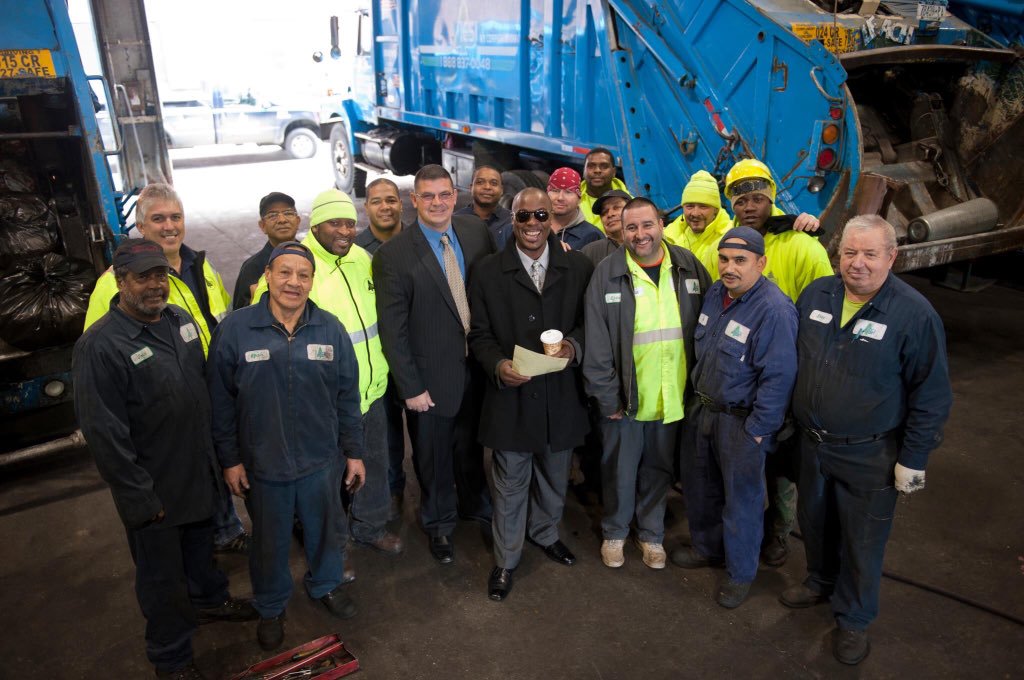
(photo: @laborers108)
A quiet announcement recently by the Business Integrity Commission - the watchdog agency that regulates the city’s food and fish wholesale markets, commercial waste services, and shipboard gambling - is unlikely to be etched in the history books or remembered for decades to come.
But it marked a significant turning point in an unnecessarily contentious dialogue between city officials and the companies that daily manage 12,000 tons of waste, recyclables, and organics generated by the city’s businesses and institutions – as well as labor leaders, and environmental and transportation safety advocates.
The announcement – a new safety manual for the city’s trade waste sector – is the result of an unprecedented collaboration.
Traditionally, commercial waste is an industry that everyone loves to hate – its big, loud trucks; its late-night collections; and its odors make it an easy target for vilification. It’s easier to blame others for the garbage all of us generate and we wish to forget, and to take for granted what’s required every night, 365 days a year, to keep our city clean, productive, and ready for the next day.
This new manual pulls together best practices for every step of the process from putting a truck on the road through its safe return every morning with its driver and helper aboard, without damage to people or property with which it might interact while on the streets.
That’s no easy job. In fact, waste-related jobs are among the top five most dangerous in the nation.
The just-published manual arose from the creation of an advisory board to guide the city’s controversial intention to replace the open-market system that promotes efficiency, choice, competition, and innovation with a system of geographic zones and exclusive franchise rights.
While we strongly disagree with the zone-based initiative, the effort led by BIC Commissioner Brownell proved that other approaches are possible – with actual results sooner, better and cheaper than waiting five years or more for a system with city government-initiated contracts to be designed, adopted, and implemented. In that same period, multiple safety initiatives could be implemented – all trucks soon will have cleaner engines, most new trucks will have cameras and all with have sideguards, and more frequent safety training could be initiated, with active engagement with the industry’s leading unions.
All that is necessary is commitment, and good-faith efforts by all concerned. If nothing else, safety is a “safe space” for those who chose to be adversaries on other matters.
This joint effort provides two takeaways:
First, the commercial waste industry – nationally and locally – makes safety a high priority.
Local efforts include semi-annual industry-city symposiums focused on safety (the fourth is scheduled for April); installation of protective side-guards; and renewed commitments to employee training, proper management, and personal protective equipment.
Second, safety requires “continuous improvement,” it’s never “over.” To be successful, the effort must be maintained by all concerned.
We know that safety is not an event, achieved through a single action. To that end, the new safety manual isn’t the first safety-focused effort and it won’t be the last.
We share commitment to the de Blasio administration’s Vision Zero goals and new solutions to street-design, traffic control, and street-sharing, which are impressive in their results to make the city a safer place to walk, bike, and drive.
But we also recognize the daily challenges of operating safely with heavy equipment, picking up bags, moving containers, and at night, in all kinds of weather, and under less than ideal conditions.
Unfortunately, safety is the only working group formed. Perhaps others now will be initiated with good-faith efforts by all concerned to improve licensing, operations, and labor standards, as well as effective zero waste initiatives.
Beyond safety, we hope the collaborative effort that created this manual will serve as a model for how disparate stakeholders can find effective ways to work together to address a compelling public issue.
***
Fritz Schneider is business manager of Laborers Local 108. Jose Maldonado is principal of Maldonado Associates, LLC and senior advisor to New Yorkers for Responsible Waste Management, and previously served as commissioner of the city’s Business Integrity Commission. On Twitter @laborers108.
***
Have an op-ed idea or submission for Gotham Gazette? Email This email address is being protected from spambots. You need JavaScript enabled to view it.
GothamTalks: Fighting Alzheimer's Disease & Supporting Caregivers of Those Suffering

Gotham Gazette and New Leaders Council -- a nonpartisan, nonprofit leadership institute -- have partnered with Manhattan Neighborhood Network to create a series of video commentaries by New York City civic activists. GothamTalks is short video essays submitted through the New Leaders Council alumni network, which consists of hundreds of New Yorkers working in advocacy, government, campaigns, nonprofits, business, law, and other aspects of city life.
Like both the reporting we do at Gotham Gazette and the written op-ed columns we publish, the GothamTalks video commentaries range in subject, but are all meant to move the public discussion forward. Please watch, listen, and let us know what you think. Use #GothamTalks on social media, and tag us @GothamGazette and @NLC_NYC.
Note: The views expressed in GothamTalks are entirely those of the commentators, and not of Gotham Gazette or New Leaders Council.
************
March 1, 2018
Crystal Hudson
Fighting Alzheimer's Disease & Supporting Caregivers of Those Suffering




